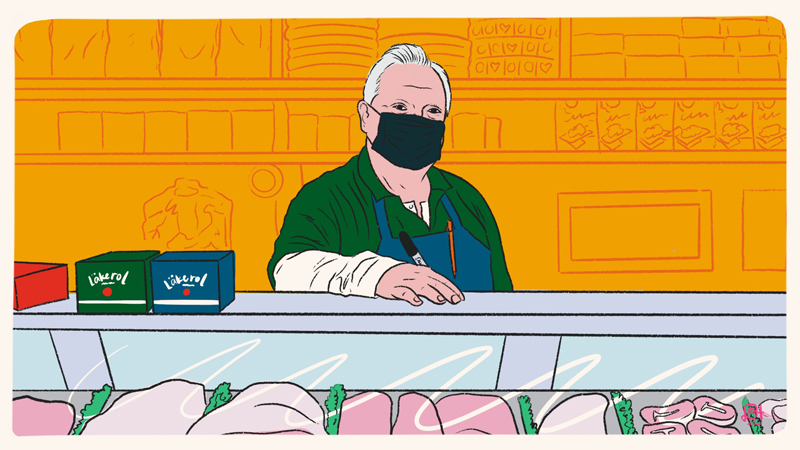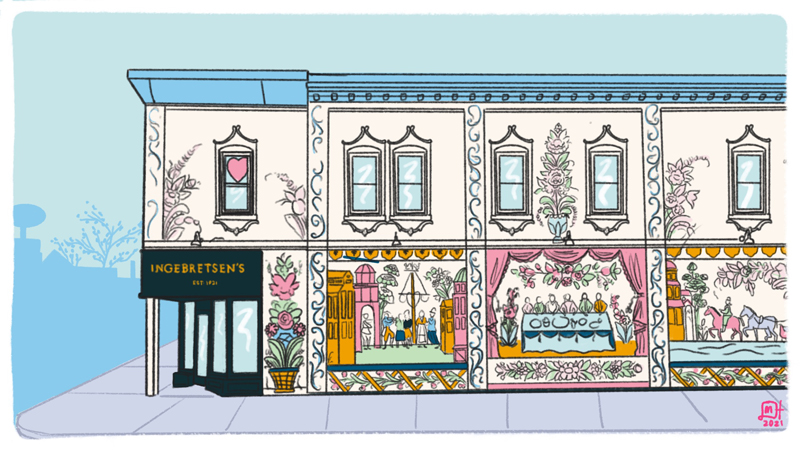ILLUSTRATIONS BY LORA MARIE HLAVSA
Funding for the Heavy Table’s Lake Street Profiles series is provided by a grant from Peace Coffee and the Coffee Creates Community initiative. Lake Street Profiles is Heavy Table’s ongoing six-part series of conversations with culinary business owners on or near East Lake Street in Minneapolis.
The line is blurred as to when Anna Bloomstrand, a fourth-generation family member, officially started working at Ingebretsen’s Nordic Marketplace. “You know, it’s a family business, so where do you say when I started?” she laughs. “I started when I was born. I actually slept in a file cabinet drawer there when I was a baby. An open one.”
The marketplace, which celebrates its 100th birthday this year, still stands in its original location on East Lake Street, though back then it was known as Model Meat Market. Charles Ingebretsen Sr. opened the first market in Cedar-Riverside, a neighborhood that was then thick with immigrants from Norway, Sweden, and Denmark, before expanding to two locations along Lake Street.
At the time, Charles’ focus was on providing his fellow recent Scandanavian immigrants with the specific ingredients that were otherwise hard to find in Minneapolis. “Essentially it was back when the neighborhood was primarily Scandanavian immigrants, so it was kind of like our bodega or halal market,” says Bloomstrand, the great-granddaughter of Charles.
But as they’ve moved further and further from the original wave of immigrants at the turn of the 20th Century—and as the descendants of the original immigrants have spread out into the suburbs—the shop’s focus has evolved from sheer utility more towards a place to link people with their heritage, whether it be through food or craft. “We have this unique position of really being rooted in our ancestral background, which is not the norm for European Americans who have come over here. That’s something that’s really missing,” says Bloomstrand. “So I feel really lucky to be a part of people feeling connected to the things that are important to themselves. […] It’s really special.”
 Whether it’s their high-demand Swedish meatball mix or customary folk art, people flock from afar to feel a connection to their family lineage, especially over the holiday season. Walking through Ingebretsen’s is like taking a step back in time, as if the culture of early-1900s Scandinavia were perfectly encased in their glass meat case. Bloomstrand (illustrated above right with her mother, Julie Ingebretsen) says that she’s spoken with Swedish expats in the U.S. who’ve noted that the shop embraces elements of a cultural past, with foods and folk crafts the people of Sweden or Norway might associate with their grandparents. “There is this kind of stasis of immigrant cultures,” Bloomstrand says. “When they come here, it’s kind of the time of their home country that they represent moving forward—and what they hand down—while their home country just moves on.”
Whether it’s their high-demand Swedish meatball mix or customary folk art, people flock from afar to feel a connection to their family lineage, especially over the holiday season. Walking through Ingebretsen’s is like taking a step back in time, as if the culture of early-1900s Scandinavia were perfectly encased in their glass meat case. Bloomstrand (illustrated above right with her mother, Julie Ingebretsen) says that she’s spoken with Swedish expats in the U.S. who’ve noted that the shop embraces elements of a cultural past, with foods and folk crafts the people of Sweden or Norway might associate with their grandparents. “There is this kind of stasis of immigrant cultures,” Bloomstrand says. “When they come here, it’s kind of the time of their home country that they represent moving forward—and what they hand down—while their home country just moves on.”
While this uniquely forged Scandinavian-Minnesotan subculture shares similarities with the homeland, there are some more kitsch elements that are so endearingly American—while lutefisk is still eaten by some for certain holidays and celebrations in Norway, visitors of Madison, Minnesota, the self-proclaimed “Lutefisk Capital of the USA”, are greeted upon arrival with a giant roadside attraction named Lou T. Fisk.
But Ingebretsen’s doesn’t lean into the novel kitsch so much, focusing more on the beloved customs and cuisine to keep the heritage alive for younger generations. “We’re super conscious of the things that make us unique, and also the things that people are really connected to,” says Bloomstrand. Fans of the food are incredibly dialed in, often having relied on it for generations. “If we change a touch of salt in anything, it’s a nightmare for some people. People really understand those flavors.”
‘IT’S KIND OF LIKE EVERYBODY’S RESPONSIBLE, BUT NOBODY’S RESPONSIBLE’
In a neighborhood that has seen tidal shifts in demographic since the shop’s beginnings in 1921—back when Lake Street was still near the edge of town, Bloomstrand says—the family has stayed cognizant of their longstanding position in the community, offering their help and support to newer immigrant-owned businesses wherever they can. Bloomstrand’s mother, Julie Ingebretsen, has spent years advocating for Lake Street businesses as a member of the Lake Street Council. In the 1970s, while her dad continued on the food side of the business, she started growing the shop to offer more material goods and crafts, which now makes up a large chunk of the business. Bloomstrand credits her mother’s soft, steady demeanor for the business’s growth and success. “My mom has a very quietly savvy way of knowing how to build community in a way that really resonates with Scandanavians, which is like, quietly,” she says. “There’s this gentleness about the way that we’ve been part of this space for such a long time, and it just really resonates with people.”
 When 2020 started rearing its hideous head last March, Ingebretsen’s suffered the same impacts as any other small business in their neighborhood—but thanks to their business acumen and loyal community of supporters near and far, they were able to hang on as the pandemic set in. But on top of a pandemic that already effectively brought the small-business community to its knees, the riots following the killing of George Floyd left much of East Lake Street in smoldering shambles, revealing to the light of day what Bloomstrand says have been long-ignored issues with the way the area is managed by the city.
When 2020 started rearing its hideous head last March, Ingebretsen’s suffered the same impacts as any other small business in their neighborhood—but thanks to their business acumen and loyal community of supporters near and far, they were able to hang on as the pandemic set in. But on top of a pandemic that already effectively brought the small-business community to its knees, the riots following the killing of George Floyd left much of East Lake Street in smoldering shambles, revealing to the light of day what Bloomstrand says have been long-ignored issues with the way the area is managed by the city.
“An aspect of Lake Street that I think is really important that people don’t understand very much—unless they’re super hyper-locally focused on what’s going on on Lake Street—it is a prime example of a multi-jurisdictional space. So there is a lot of responsibility that lives on Lake Street on all levels of government,” she says. “Because that’s true, it’s kind of like everybody’s responsible, but nobody’s responsible. You know what I mean? And this surfaces in a million different ways for us.”
Bloomstrand, who grew up in South Minneapolis, says that business organizations like the Lake Street Council and Longfellow Business Association have had to step up when local government has failed to offer any meaningful aid to impacted areas. “I don’t know if it’s out of sight, out of mind, I don’t know. But it’s been really disappointing, and it’s put a lot of pressure on these smaller business organizations […] to be the end-all-be-all for resources out into the community. In a lot of ways that is their role, but I would love to see more partnership on all levels.”
Though Ingebretsen’s suffered debilitating damage in property and inventory from the riots—they weren’t able to reopen until September—the business is entirely supportive of the fight against police brutality that fueled the protests. A self-proclaimed optimist, Bloomstrand says she’s hopeful that the events of the past year will spur legitimate changes in the future of Lake Street, ranging from more substantial support for businesses to new ways of addressing public safety. “It’s not just doling out funds—I think there needs to be more organization, period. And it needs to be all the time, not just when there’s a crisis.”
As Ingebretsen’s starts transitioning into its next generation of operators—namely Bloomstrand and her cousin Gus Ingebretsen, who runs the mail-order side of the business—the family is starting to look at what the future might hold. Having just closed down their satellite store in Stockholm, Wisconsin, they’re back to their main location on Lake Street and their shop in the Norway House off of Franklin Avenue. Bloomstrand, who also runs a separate wholesale business out of the shop providing Scandinavian-focused goods for small retailers across the country, says that she’s eager to focus more on minding their own ecological and cultural impact as a business in an ever-changing neighborhood.
Though there’s never been an easy day in the shop’s century-long run, Bloomstrand says there’s nothing else she’d rather be doing than working with her family, come riot or pandemic. “It’s really hard, and you don’t do it because it makes you money. You don’t do it because it’s like, prestige or anything. You do it because you love it and it’s your family and it’s your home.”

